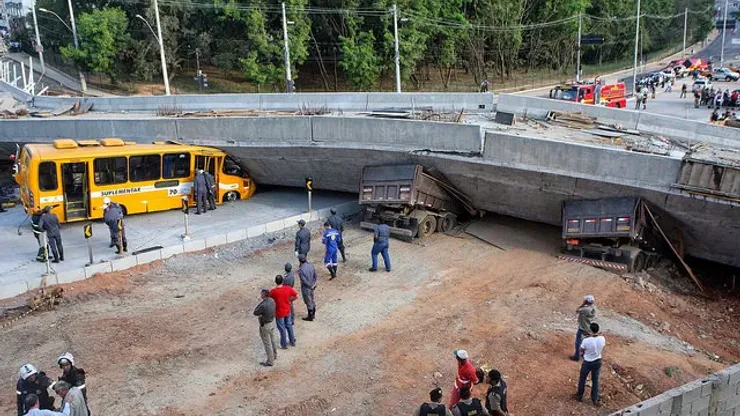You may have heard the news reports that two people died on Thursday when an overpass, which was supposed to be ready for the World Cup in Belo Horizonte to connect the international airport to the stadium area, collapsed, flattening a car, two trucks and trapping a bus. More than twenty people were injured in the accident. For city officials and FIFA, they were lucky the death toll wasn’t greater.
Breathing a sigh of relief, FIFA must be thankful that the bridge collapsed on a day when no matches were taking place otherwise the accident combined with a greater death toll would have overshadowed Tuesday’s semi-final in Belo Horizonte between Brazil and Germany.
But the fact still remains that two people are dead, and more than twenty others were injured. They may not have all been fans who traveled from faraway places to Brazil, but they were men and women working in accordance with the World Cup to make passage easier for soccer fans. These workers, like the the two men who died when a crane collapsed late last year while building Sāo Paulo’s Itaquerāo stadium, are the unsung heroes of Brazil’s World Cup.
Unfortunately, it gets worse for the host nation.
FIFA, busy pointing the finger at another World Cup’s reported flaws (yes, the one in Qatar no less than 8 years from now) and odiously casting aside the merited street-demonstrators trying to make their case heard, has also shelved any real concern for the quality of infrastructure in Brazil.
Many who followed Brazil’s trajectory to finally hosting the World Cup view the bridge collapse as little surprise. At this moment in time, with six more matches to be played until the tournament wraps up on July 13, nobody wants to witness another construction accident, but one has to wonder what if.
The harsh reality is that Brazil is ranked by the ILO as fourth in the world when it comes to work-related fatalities.
In the last 10 years alone, there have been numerous accidents that brings Brazil’s construction practices into question. In 2004, at least three people drowned after the Camara Dam burst in Paraíba, and six years earlier the Palace II residential tower block collapsed in Rio de Janeiro due to faulty engineering practices that killed eight people. Another residential block in Rio, this time more than one building, collapsed only two years ago in 2012, this time resulting in more than 15 deaths. The reason: illegal renovations.
Lastly, and perhaps the worst of all, seven people descended to their deaths during a game between Bahia and Vila Nova in 2007 when part of the stadium collapsed.
FIFA has in effect turned a blind eye to the notoriously decrepit construction practices that plague Brazilian infrastructure. A 2005 study from the Brazilian Ministries of Labor and Employment and Social Security highlighted that the “areas of the highest number of deaths are transport, storage and communications, with seven deaths reported among 3,855 workers; the Construction Industry, with six deaths for 6,908 workers; and Commerce and Repair of Vehicles with five deaths among 24,782 workers.”
Although building and stadium accidents are not unique to Brazil only, it is more so FIFA’s inability to implement sanctions, punish, or at least control the safety of host nations when it sees clearly, years in advance, that the host nation is not suitable to control the factors that determine safety and corruption.
While Thursday’s bridge collapse deals directly with the ministries’ statistics of where exactly work-related deaths occur most, everyone can only hope that no repeat of the carnage reoccurs. Belo Horizonte, the name of the city where the under-construction bridge fell, literally translates into English as Beautiful Horizon, and despite infrastructural shortcomings of this year’s World Cup, all soccer fans worldwide should hope no such incident happens again.
But if anyone should be most hopeful – and most worried, it’s FIFA.
200+ Channels With Sports & News
- Starting price: $33/mo. for fubo Latino Package
- Watch Premier League, Women’s World Cup, Euro 2024 & Gold Cup
The New Home of MLS
- Price: $14.99/mo. for MLS Season Pass
- Watch every MLS game including playoffs & Leagues Cup
Many Sports & ESPN Originals
- Price: $10.99/mo. (or get ESPN+, Hulu & Disney+ for $14.99/mo.)
- Features Bundesliga, LaLiga, Championship, & FA Cup
2,000+ soccer games per year
- Price: $5.99/mo
- Features Champions League, Serie A, Europa League & Brasileirāo
175 Premier League Games & PL TV
- Starting price: $5.99/mo. for Peacock Premium
- Watch 175 exclusive EPL games per season






